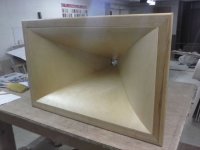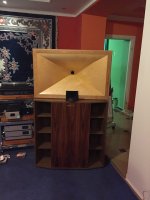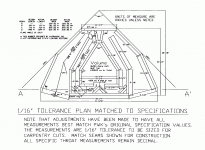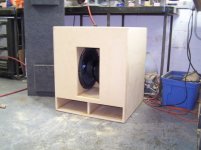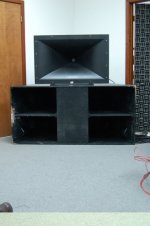Hi all.
Time for the next speaker project.
I have had Khorns and more recently Altec 19's. I want to combine the best of both worlds and build a 2-Way Jubilee-like speaker.
Speaking with ALK Engineering - they are happy to provide crossovers, and has recommended Eminence bass drivers and B&C HF units. I am aware of comparable HF units that should work, but I wonder if anyone would like to recommend alternatives to the Eminence 12" units. (I had Eminence drivers in the KHorns and was never entirely sold on them... Happy to be schooled)
Not sure what HF horn I will use, but that will sort itself out.
Plans. I need plans. I have seen a few different drawings kicking around the net - I wonder if there has been a consensus on a design which is close to the Klipsch design? Can anyone point me in the right direction?
I appreciate that this will have been covered somewhat in the past, and I have trawled through a lot of information here and elsewhere. Assistance from those who have build Jubilee clones would be MUCH appreciated.
Many thanks.
Time for the next speaker project.
I have had Khorns and more recently Altec 19's. I want to combine the best of both worlds and build a 2-Way Jubilee-like speaker.
Speaking with ALK Engineering - they are happy to provide crossovers, and has recommended Eminence bass drivers and B&C HF units. I am aware of comparable HF units that should work, but I wonder if anyone would like to recommend alternatives to the Eminence 12" units. (I had Eminence drivers in the KHorns and was never entirely sold on them... Happy to be schooled)
Not sure what HF horn I will use, but that will sort itself out.
Plans. I need plans. I have seen a few different drawings kicking around the net - I wonder if there has been a consensus on a design which is close to the Klipsch design? Can anyone point me in the right direction?
I appreciate that this will have been covered somewhat in the past, and I have trawled through a lot of information here and elsewhere. Assistance from those who have build Jubilee clones would be MUCH appreciated.
Many thanks.
Apples n' oranges comparison...........
Dunno, these are the only ones I've seen...........
Sorry, you do not have permission for that!
Sorry, you do not have permission for that!
..........except this partial you can compare with which includes numerous driver options:
Need some advice for bass section in diy horn setup
GM
Dunno, these are the only ones I've seen...........
Sorry, you do not have permission for that!
Sorry, you do not have permission for that!
..........except this partial you can compare with which includes numerous driver options:
Need some advice for bass section in diy horn setup
GM
I don't know much about the various drivers....but... I have owned a pair of Jubilee's for something like 12 years now... so have some experience with them.
My 2-cents.... the 'secret sauce' in the speaker is the K402 horn. That horn sounds fantastic sitting on top of a LaScala bass bin, Jubilee, MWM single or double or some of the DR bass bins they have using two or four 15" drivers.
I'd personally rather have the K402 on top of a LaScala bass bin than something other, on top of a Jubilee bass bin.
I don't know how it works out with a passive.... my understanding is the K402 (and it's little brother K510) are some kind of constant coverage horns. As such, they need some HF boost to balance them out. With an active, just plug in the numbers. I don't know how you can do that with a passive. I'm sure someone does, just trying to bring it to your attention.
I use an active, never used a passive with them.
My 2-cents.... the 'secret sauce' in the speaker is the K402 horn. That horn sounds fantastic sitting on top of a LaScala bass bin, Jubilee, MWM single or double or some of the DR bass bins they have using two or four 15" drivers.
I'd personally rather have the K402 on top of a LaScala bass bin than something other, on top of a Jubilee bass bin.
I don't know how it works out with a passive.... my understanding is the K402 (and it's little brother K510) are some kind of constant coverage horns. As such, they need some HF boost to balance them out. With an active, just plug in the numbers. I don't know how you can do that with a passive. I'm sure someone does, just trying to bring it to your attention.
I use an active, never used a passive with them.
I know nothing about active crossovers. Might be time to start learning.
See Active Bi-Amping/Tri-Amping FAQ - Technical/Modifications - The Klipsch Audio Community
A lot of people seem to hung up on building the bass bin part, but as Coytee (Richard) has said, the real performing part of the Jubilee is actually the K-402 with a low-chatter 2" compression driver. This is the part that provides the "Jubilee sound". The bass bin...well, not as much, but it's still important. The K-402 assemblies are available from Klipsch with compression drivers attached for about $1.2k(US) each. If you wish to make them out of something like wood, I strongly recommend that you have a real K-402 on hand to use as a pattern, otherwise you're likely not going get the real McCoy in terms of polar coverage (vertical/horizontal).
The Jubilee bass bin is a "W" section design like the Khorn, La Scala, and Belle bass bins, which means it has two mouths. The problem with that is that the two (truncated) horn mouths begin to interact with each other above 200 Hz, i.e., two-source interference--like a dual slit wavefront experiment that is commonly seen in physics demonstrations, thus producing extremely narrow horizontal polar coverage above that frequency. This has implications in midbass performance that are audible.
The La Scala is the only one of the four designs that doesn't do this--because the two mouths are rejoined at the front of the bass bin mouths, thus avoiding the two source interference issue. You could make DIY La Scala bass bins, but they really cut off about an octave and a half too high--about 100 Hz (without boundary gain). The key is the rejoining of the mouths.
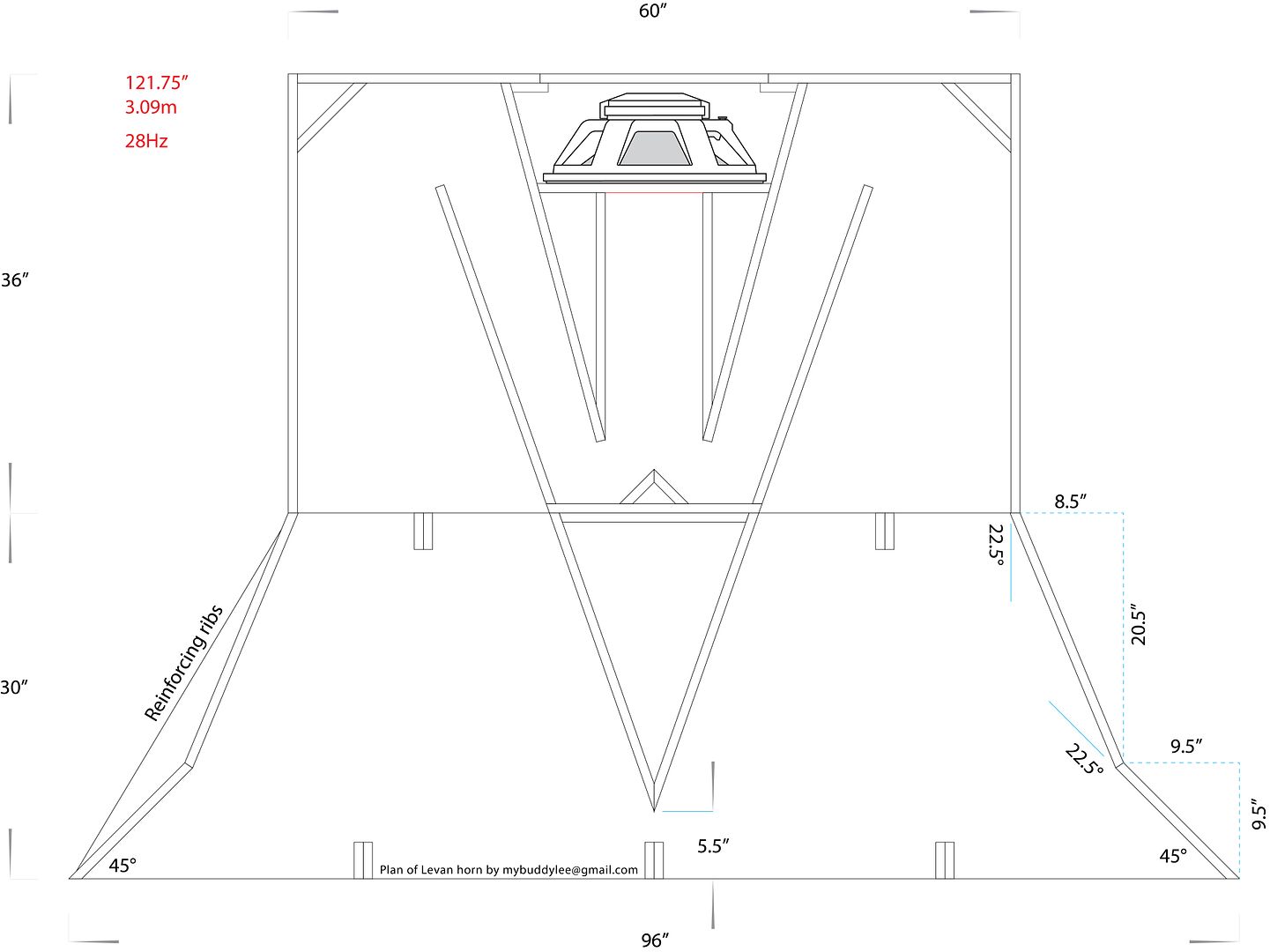
If you designed a longer path length folded horn--like half a Jubilee bass bin or a nautilus/snail/spiral design. (also here and here)--you'd avoid the dual mouth "W" section problem.

Presently, I'd recommend Faital Pro HF200 series 2" compression drivers for the K-402s in a two-way configuration (like the Klipsch Jubilee) if you can get them at a reasonable price. I'd avoid P.Audio, B&C and the like because of the diaphragm chattering issue above 10 kHz. Note that almost any beryllium diaphragm 2" throat driver will sound the best, followed by a well EQed and dialed in BMS 4592ND (the dual diaphragm version), then closely followed by the Faital Pros, then other compression drivers, in my experience.
I don't personally recommend a 3-way design since the time alignment requirement is on the order of ±1 cm, something that will go in and out of alignment simply by sitting or standing up relative to a K-402 horn on top of a bass bin using a separate tweeter due to the vertical distance between the two horn axes (...yes, it really does this).

If you're into Synergy horns™ (i.e., multiple entry horns--MEHs), then this design will avoid the need for the bass bins by using the K-402 to its full potential: A K-402-Based Full-Range Multiple-Entry Horn - Technical/Modifications - The Klipsch Audio Community
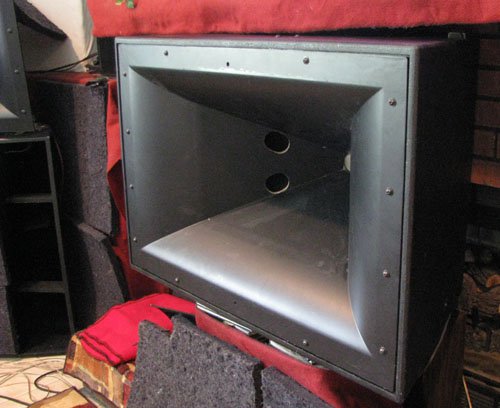
Chris
Last edited:
Google: K-402 wood
K-402 in wood!
klipsch 402 wood horn - Google Search
========
There are only rough cut plans for the Jubilee bass horn on the web to avoid any legal issues.
Klipsch uses their K31 speaker in Jubliee
DIY'ers sometimes use
1) $127 Eminence Kappa_Pro_12A
2) $120 Crites CW1228
3) $250 GPA-414-8B
K-402 in wood!
klipsch 402 wood horn - Google Search
========
There are only rough cut plans for the Jubilee bass horn on the web to avoid any legal issues.
Klipsch uses their K31 speaker in Jubliee
DIY'ers sometimes use
1) $127 Eminence Kappa_Pro_12A
2) $120 Crites CW1228
3) $250 GPA-414-8B
Attachments
Last edited:
I will have to third or fourth that the magic in the Jubilee is the K-402. It remains the only horn system I have heard that completely impressed me; wholly point source image with no discontinuities that I'm sensitive to from multiple horn systems.
I have lurked the Klipsch forum and from what I have been able to piece together from Roy there are some "tricks" to the K-402 that may not be clonable without having the real thing side by side. I would personally much rather have one in wood as the finish on the commercial version (even new) looks like it was built for PA installation with scrapes, paint missing, etc. Not very appealing considering how expensive they are.
I have lurked the Klipsch forum and from what I have been able to piece together from Roy there are some "tricks" to the K-402 that may not be clonable without having the real thing side by side. I would personally much rather have one in wood as the finish on the commercial version (even new) looks like it was built for PA installation with scrapes, paint missing, etc. Not very appealing considering how expensive they are.
Push-Pull-Slot-Loaded woofers
Has anyone used the K-402 horn with a Push-Pull-Slot-Loaded woofer?
Not as corner-friendly as the Jubilee. Much easier construction.
PPSL woofers have a good Directivity Index(DI), which produces a better integration to a midrange horn than a basic bass reflex ported woofer.
Has anyone used the K-402 horn with a Push-Pull-Slot-Loaded woofer?
Not as corner-friendly as the Jubilee. Much easier construction.
PPSL woofers have a good Directivity Index(DI), which produces a better integration to a midrange horn than a basic bass reflex ported woofer.
Attachments
Push-Pull-Slot-Loaded woofers
Has anyone used the K-402 horn with a Push-Pull-Slot-Loaded woofer?
Not as corner-friendly as the Jubilee. Much easier construction.
PPSL woofers have a good Directivity Index(DI), which produces a better integration to a midrange horn than a basic bass reflex ported woofer.
Has anyone used the K-402 horn with a Push-Pull-Slot-Loaded woofer?
Not as corner-friendly as the Jubilee. Much easier construction.
PPSL woofers have a good Directivity Index(DI), which produces a better integration to a midrange horn than a basic bass reflex ported woofer.
Thanks again for the responses.
Yes, I imagine there is all manner of bins that I could build. I fully appreciate that horn cabinets will have their quirks and issues - living with K-Horns in several different houses made me aware of these. Still loved 'em.
I like the Jubilee bins for several reasons:
1) One helluva woodwork project
2) One helluva woodwork project
3) They are (supposedly) a significant improvement on the K-Horn design I loved
4) I can get crossovers - the system is known. I'm no good on electronics.
5) I can probably nestle them into the corners of two room choices I have.
6) Should be a good match for flea powered SET gear @ 105+db for the system
It certainly seems to be the consensus that the K402 is the heart of the system. Yes, I would love to build some of these, but very much doubt I would attempt it without an original nearby, as suggested. IT does not sound like I would have a tough job on-selling them if necessary.....
Thanks again for the stimuli.
Coelacanth
Yes, I imagine there is all manner of bins that I could build. I fully appreciate that horn cabinets will have their quirks and issues - living with K-Horns in several different houses made me aware of these. Still loved 'em.
I like the Jubilee bins for several reasons:
1) One helluva woodwork project
2) One helluva woodwork project
3) They are (supposedly) a significant improvement on the K-Horn design I loved
4) I can get crossovers - the system is known. I'm no good on electronics.
5) I can probably nestle them into the corners of two room choices I have.
6) Should be a good match for flea powered SET gear @ 105+db for the system
It certainly seems to be the consensus that the K402 is the heart of the system. Yes, I would love to build some of these, but very much doubt I would attempt it without an original nearby, as suggested. IT does not sound like I would have a tough job on-selling them if necessary.....
Thanks again for the stimuli.
Coelacanth
these speakers sound like dog ****
Seems like a highly intelligent response. Thanks. I will abandon my plans on your recommendation and take up golf.
1. It does seem to be a woodwork project however, it's much less of one than the Khorn
2. See above
3. They are unarguably a significant improvement. I DREAMED of owning Khorns for years, finally got a pair. Several years later, was at the factory and heard their demo. During the first 20 second intro of Hotel California, once that drum hit (they were using a single Jubilee mind you) I was ear to ear smile, turned to the person next to me and said THAT is what I've been looking for!!! I ordered them that week and sold the Khorns literally within 3 hours of getting home & listing them. They will soundly outperform a Khorn in just about any way you want to measure it.
4. Yeah you can buy/build a passive. I think Roy's thoughts are if you want the "nth" degree of improvement, you should go active
5. Even if you can't, they have more wiggle room than Khorns. I understand that as long as you are within "about 10 inches" from the corner, you'll get full performance
6. I had those with my Khorns... then went higher power. Today, I have a single Crown K2 dedicated to each speaker. Overkill but system is still hiss-less (as in without hiss) and has the ability to punch you in the gut if someone leans into the volume too much. Yeah, I'm a dynamics *****.
I've seen some beautifully finished clones. You can't really hide the top horn easily (if you go 402) but the rest of it can be beeeeeautiful if done right.
Good luck in whatever you pursue!!
2. See above
3. They are unarguably a significant improvement. I DREAMED of owning Khorns for years, finally got a pair. Several years later, was at the factory and heard their demo. During the first 20 second intro of Hotel California, once that drum hit (they were using a single Jubilee mind you) I was ear to ear smile, turned to the person next to me and said THAT is what I've been looking for!!! I ordered them that week and sold the Khorns literally within 3 hours of getting home & listing them. They will soundly outperform a Khorn in just about any way you want to measure it.
4. Yeah you can buy/build a passive. I think Roy's thoughts are if you want the "nth" degree of improvement, you should go active
5. Even if you can't, they have more wiggle room than Khorns. I understand that as long as you are within "about 10 inches" from the corner, you'll get full performance
6. I had those with my Khorns... then went higher power. Today, I have a single Crown K2 dedicated to each speaker. Overkill but system is still hiss-less (as in without hiss) and has the ability to punch you in the gut if someone leans into the volume too much. Yeah, I'm a dynamics *****.
I've seen some beautifully finished clones. You can't really hide the top horn easily (if you go 402) but the rest of it can be beeeeeautiful if done right.
Good luck in whatever you pursue!!
Since you're going to build the Jubilee bass bin design, a few words on that:
1) I'd recommend plotting the area expansion vs. linear distance from the woofer baffle to check the dimensions that you see online in the DIY versions. I believe that there are issues...because I've helped to dial-in DIY Jubilee bass bins using a DSP crossover, and I saw some frequency response issues relative to the factory-produced versions, particularly down low close to the 40 Hz design cutoff point. A plot for a La Scala bass bin for reference (thanks again Greg for your Hornresp work):

2) I assume that you're going to use some other type of woofer than the K-31s. Here is a thread on alternative woofers and their performance relative to the K-31s (I'd pay particular attention to "Edgar" posts using Hornresp plots): Better woofer for Jubilee? - Technical/Modifications - The Klipsch Audio Community. I'd also do what you need to do to ensure better low frequency power performance than the HF, as predicted from Hornresp.
Sealing up the back chamber, put some flexible foam of about 1/2" thickness to control back chamber reflections, and watching the transitions in the fold areas of the horn to make sure that the area expansion is as uniform as you can make it--all these things will increase its low frequency performance.
3) Also, when you initially run in the bass bins, remember that the woofers loosen up considerably during the first day or two of continuous use, so any measurements initially should take that into consideration.
Chris
1) I'd recommend plotting the area expansion vs. linear distance from the woofer baffle to check the dimensions that you see online in the DIY versions. I believe that there are issues...because I've helped to dial-in DIY Jubilee bass bins using a DSP crossover, and I saw some frequency response issues relative to the factory-produced versions, particularly down low close to the 40 Hz design cutoff point. A plot for a La Scala bass bin for reference (thanks again Greg for your Hornresp work):

2) I assume that you're going to use some other type of woofer than the K-31s. Here is a thread on alternative woofers and their performance relative to the K-31s (I'd pay particular attention to "Edgar" posts using Hornresp plots): Better woofer for Jubilee? - Technical/Modifications - The Klipsch Audio Community. I'd also do what you need to do to ensure better low frequency power performance than the HF, as predicted from Hornresp.
Sealing up the back chamber, put some flexible foam of about 1/2" thickness to control back chamber reflections, and watching the transitions in the fold areas of the horn to make sure that the area expansion is as uniform as you can make it--all these things will increase its low frequency performance.
3) Also, when you initially run in the bass bins, remember that the woofers loosen up considerably during the first day or two of continuous use, so any measurements initially should take that into consideration.
Chris
Last edited:
Chris thanks for your words.. I think I can extrapolate from them that I need to be aiming for the blue line on the graph?
I really am humbled here by people who are able to immerse themselves in the science of speakerbuilding. I am not that way inclined. I can follow a plan easy enough, but I doubt I will ever be able to geasp the concepts that I am putting into practice when I build something....
Which is why I appreciate the advice.
I am looking forward to building the cabinets for the jubes. Really do hope I can recreate the magic. Love the KHorns so with luck I will end up north of their performance.
Equally however............
If someone wants to direct me to a bass bin design that will work in place of the Jubilee horn bins, is proven, and will integrate with low power valves (ie be efficient) I would certainly have a look....
(Emphasis on proved designs)
Thanks again
I really am humbled here by people who are able to immerse themselves in the science of speakerbuilding. I am not that way inclined. I can follow a plan easy enough, but I doubt I will ever be able to geasp the concepts that I am putting into practice when I build something....
Which is why I appreciate the advice.
I am looking forward to building the cabinets for the jubes. Really do hope I can recreate the magic. Love the KHorns so with luck I will end up north of their performance.
Equally however............
If someone wants to direct me to a bass bin design that will work in place of the Jubilee horn bins, is proven, and will integrate with low power valves (ie be efficient) I would certainly have a look....
(Emphasis on proved designs)
Thanks again
Chris thanks for your words.. I think I can extrapolate from them that I need to be aiming for the blue line on the graph?
I really am humbled here by people who are able to immerse themselves in the science of speakerbuilding. I am not that way inclined. I can follow a plan easy enough, but I doubt I will ever be able to geasp the concepts that I am putting into practice when I build something....
Which is why I appreciate the advice.
I am looking forward to building the cabinets for the jubes. Really do hope I can recreate the magic. Love the KHorns so with luck I will end up north of their performance.
Equally however............
If someone wants to direct me to a bass bin design that will work in place of the Jubilee horn bins, is proven, and will integrate with low power valves (ie be efficient) I would certainly have a look....
(Emphasis on proved designs)
Thanks again
If you have the space, you might look at their MWM cabinets. Bigger horn, single OR double driver design.... and in my mind (as an owner of Jubilee's for over a decade) can stomp all over the Jubilee.
They are however, really really really big..... something like six feet wide, four feet deep (if you took their design to a full "squared" back design, since it's truncated it might not be that deep) and 18 or 36 inches tall, depending if you go single or double driver.
They are however, absolutely effortless with their output.
Disclaimer: I'll admit I don't know/understand enough about designs to know how it would interact with low powered amps.... they are however, very sensitive.
Attachments
Actually, the idea is that you should aim for smooth expansion with the fewest sudden jumps or flat (zero) expansion rate. The La Scala bass bin has one small jump in expansion and one area of zero expansion.Chris thanks for your words.. I think I can extrapolate from them that I need to be aiming for the blue line on the graph?
The places to look the most carefully are at the turns and the local minima of cross sectional area to see if you can make the cross sectional area expansion rate as smooth as possible from the throat to the mouth. It's really just a paper plot exercise and the willingness to adjust the dimensions of the DIY Jubilee cross section drawing that you see online. Little changes in dimension add up to big potential gains in performance.
Also, be extremely careful to seal the back chamber behind the woofers until it's air tight. This includes the woofer mounting surface to the plywood and the drivers' surrounds on the woofers with rubber cement, etc. if they've got pin hole leaks. The test for air tightness used to be to depress the woofer in the back chamber direction, then count the number of seconds until the woofer returns to normal position. Three to five seconds is a good number. (This can only be done with a partially assembled bass bin that allows access to the woofer to push on it before the structure of the bass bin folds precludes you being able to do this manually.)
Also be careful with the area just around the woofer baffle slot - make sure that no obstructions or rubbing against the woofer cones/surrounds exist and that the cones don't touch any plywood structure even when exercise to their xmax values (either in positive or negative stroke directions).
Chris
- Home
- Loudspeakers
- Multi-Way
- Klipsch Jubilee Clone Build factfinding mission
